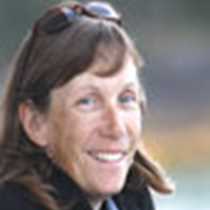Petersburg
Today began just how yesterday ended, with the determined and enthusiastic among us dressed for the weather, outside on the bow, and delighting in the presence of humpback whales. What a way to wake up! Many of us skipped our early morning cup of coffee and went straight to the bow when Cindy called at 6:20 a.m. We were rewarded with some amazing aerial antics. The humpbacks appeared to be feeding, staying on the surface briefly and then doing short dives. Using the depth sounder, the captain was able to see a swarm of prey, probably krill about 100 feet down. Interspersed with the dives was one breach and a few instances of pectoral flipper slapping. The grand finale before breakfast was watching Megaptera novaeangliae (Latin for humpback, meaning long-winged New Englander) show off its 15 foot long “wings” by lying on its back and slapping its pectoral flippers, repeatedly and in unison onto the water. If there is such a thing as a cetacean backstroke, this was it.
Sometimes, from a human perspective it appears that life here in Southeast Alaska is clinging to its existence by its toenails. This, of course, is not true. Things that sound complicated to us, are just the unique adaptations that a plant or animal has that makes it perfectly suited to its job and environment. We discovered amazing examples of adaptations after lunch in the Petersburg bog. Here, many plants have changed over time to be able to live in the acidic, nutrient poor, soggy soils of the muskeg. The carnivorous, round-leaved sundew is one such example. It obtains nitrogen in the form of insects that get trapped on its sticky leaf surface.
This evening we did a bit of feeding of our own. We developed our adaptations for feeding far faster than any of the plants and animals we watched today since our adaptations were necessary for dinner. There were piles of fresh Dungeness crab placed on the tables in front of us and we each came up with our own style for getting the delectable meat out of the shell. Many of us managed to eat at least one (or more) crab, despite their size being about the diameter of the lid on a gallon paint can. What a way to experience the abundance of the southeast Alaska bounty. Feasts for the eyes during the day and for the palate this evening.
Today began just how yesterday ended, with the determined and enthusiastic among us dressed for the weather, outside on the bow, and delighting in the presence of humpback whales. What a way to wake up! Many of us skipped our early morning cup of coffee and went straight to the bow when Cindy called at 6:20 a.m. We were rewarded with some amazing aerial antics. The humpbacks appeared to be feeding, staying on the surface briefly and then doing short dives. Using the depth sounder, the captain was able to see a swarm of prey, probably krill about 100 feet down. Interspersed with the dives was one breach and a few instances of pectoral flipper slapping. The grand finale before breakfast was watching Megaptera novaeangliae (Latin for humpback, meaning long-winged New Englander) show off its 15 foot long “wings” by lying on its back and slapping its pectoral flippers, repeatedly and in unison onto the water. If there is such a thing as a cetacean backstroke, this was it.
Sometimes, from a human perspective it appears that life here in Southeast Alaska is clinging to its existence by its toenails. This, of course, is not true. Things that sound complicated to us, are just the unique adaptations that a plant or animal has that makes it perfectly suited to its job and environment. We discovered amazing examples of adaptations after lunch in the Petersburg bog. Here, many plants have changed over time to be able to live in the acidic, nutrient poor, soggy soils of the muskeg. The carnivorous, round-leaved sundew is one such example. It obtains nitrogen in the form of insects that get trapped on its sticky leaf surface.
This evening we did a bit of feeding of our own. We developed our adaptations for feeding far faster than any of the plants and animals we watched today since our adaptations were necessary for dinner. There were piles of fresh Dungeness crab placed on the tables in front of us and we each came up with our own style for getting the delectable meat out of the shell. Many of us managed to eat at least one (or more) crab, despite their size being about the diameter of the lid on a gallon paint can. What a way to experience the abundance of the southeast Alaska bounty. Feasts for the eyes during the day and for the palate this evening.



